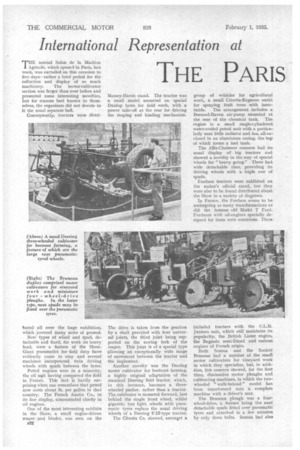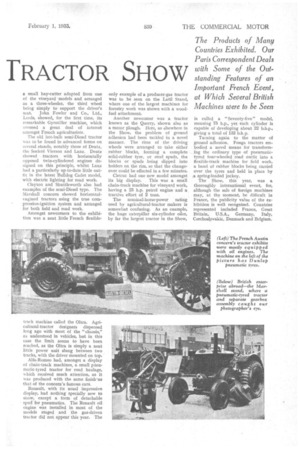THE PARIS TRACTOR SHOW
Page 32

Page 33

If you've noticed an error in this article please click here to report it so we can fix it.
THE annual Salon de la Machine Agricole, which opened in Paris, last week, was curtailed on this occasion to five days—rather a brief period for the collection and display of so much machinery. The motor-cultivator section was larger than ever before and presented some interesting novelties, but for reasons best known to themselves, the organizers did not devote to it the usual separate hall.
Consequently, tractors were distri
bitted all over the huge exhibition, which covered many acres of ground.
New types of wheel and spud, detachable and fixed, for work on heavy land, Were a feature of the Show. Giant pneumatics for field duty have evidently come to stay and several' machines incorporated twin driving wheels with spuds between the tyres.'
Petrol engines were in a minority, the oil unit having conquered the field in France. This fact is hardly surprising when one remembers that petrol now costs about 3s. per gallon in that country. The French Austin Co., in its fine display, concentrated chiefly in oil engines.
One of the most interesting exhibits in the Show, a small engine-driven reaper and binder, was seen on the e22 Massey-Harris stand. The tractor was a small model mounted on special Dunlop tyres for field work, with a power take-oft at the rear for driving the reaping and binding mechanism.
The drive is taken from the gearbox by a shaft provided with four universal joints, the third joint being supported on the towing fork of the reaper. This joint is of a special type allowing an exceptionally wide range of movement between the tractor and the implement.
Another novelty was the Deering motor cultivator for beetroot farming, a highly original adaptation of the standard Deering field t-ractor, which, in this instance, becomes a threewheeled pusher, rather than a tractor. The cultivator is mounted forward, just behind the single front wheel, whilst gigantic, but light, wheels with pneumatic tyres replace the usual driving wheels of a Deering F.12-type tractor.
The Citroen Co. showed, amongst a group of vehicles for agricultural work, a small Citroen-Kegresse outfit for spraying fruit trees with insecticide. The arrangement includes a Bernard-Bavox air-pump mounted at the rear of the chemical tank. The engine is a small single-cylindered water-cooled petrol unit with a particularly neat little radiator and fan, all enclosed in an aluminium casing, the top of which forms a fuel tank.
The Allis-Chalmers concern had its usual display of big tractors and showed a novelty in the way of special wheels for "heavy going." These had wide detachable rims, providing its driving wheels with a triple row of spuds.
Fordson tractors were exhibited on the maker's official stand, but they were also to be found distributed about the Show in a variety of disguises.
In France, the Fordson seems to be undergoing as many transformations as did the famous old Model T Ford. ' Fordsons with oil-engines specially designed for them were numerous. These
included tractors with the C.L.M. Junkers unit, which still maintains its popularity, the British Lister engine, the Bagnulo semi,Diesel and various engines of French origin.
Both Somua and the Societe Bruneau had a number of the small motor cultivators for vineyard work in which they specialize, but, in addition, this concern showed, for the first time, diminutive motor ploughs and cultivating machines, in which the twowheeled " walk-behind " model has been transformed into a complete machine with a driver's seat.
The Bruneau plough was a fourwheel-drive, a feature being the neat detachable spuds fitted over pneumatic tyres and attached in a few minutes by only three bolts, Somua had also a small hay-cutter adapted from one of the vineyard models and arranged as a three-wheeler, the third wheel being simply to support the driver's seat. John Fowler and Co., Ltd., Leeds, showed, for the first time, its remarkable Gyrotiller machine, which aroused a great deal of interest amongst French agriculturists.
The old hot-bulb semi-Diesel tractor was to be found in advanced forms on several stands, notably those of Deutz, the Societe Vierzon and Lanz. Deutz showed tractors with horizontally opposed twin-cylindered engines designed on this principle, whilst Lanz had a particularly up-to-date little outfit in the latest Bulldog Cadet model, with electric lighting for road work.
Clayton and Shuttkworth also had examples of the semi-Diesel type. The Marshall concern showed horizontaleugined tractors using the true compression-ignition system and arranged for both field and road work.
Amongst newcomers to the exhibition was a neat little French flexible
track machine called the Oltra. Agricultural-tractor designers dispensed long ago with most of the "chassis," as understood in vehicles, but in this case the limit seems to have been reached, as the Oltra is simply a neat little power unit slung between two tracks, with the driver mounted on top.
Alfa-Romeo had, amongst a display of chain-track machines, a small pneumatic-ty-red tractor for road haulage, which received much attention, as it was produced with the same finish`as that of the concern's famous cars.
Renault, with its usual impressive display, had nothing specially new to show, except a form of detachable spud' for pneumatics. The Renault oil engine was installed in most of the models staged and the gas-driven tractor did not appear this year. The only example of a producer-gas tractor • was to be seen on the Latil Stand, where one of the largest machines for forestry work was shown with a woodfuel attachment.
Another newcomer was a tractor known as the Querry, shown also as a motor plough. Here, as elsewhere in the Show, the problem of ground adhesion had been tackled in a novel manner. The rims of the driving wheels were arranged to take either rubber blocks, forming a complete solid-rubber tyre, or steel spuds, the blocks or spuds being slipped into holders on the rim, so that the changeover could be effected in a few minutes.
Cletrac had one new model amongst its big display. This was a small chain-track machine for vineyard work, having a 23 h.p. petrol engine and a tractive effort of 2 tons.
The nominal-horse-power rating used by agricultural-tractor makers is somewhat confusing. As an example, the huge caterpillar six-cylinder oiler, by far the largest tractor in the Show,
is called a "Seventy-five" model, meaning 75 h.p., yet each cylinder Is capable of developing about 22 b.h.p., giving a total of 132 b.h.p.
Turning again to the matter of ground adhesion. Fouga tractors embodied a novel means for transforming the ordinary type of pneumatictyred four-wheeled road outfit into a flexible-track machine for field work, a band of rubber blocks being carried over the tyres and held in place by ,a spring-loaded jockey.
The Show, this year, was a. thoroughly international event, for, although the sale of foreign machines may, at the moment, be difficult in France, the publicity value of the exhibition is well recognised. Countries represented included France, Great Britain, U.S.A., Germany, Italy, Czechoslovakia., Denmark and Belgium.




















































































